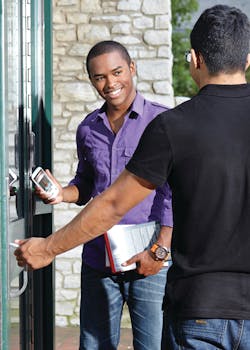Don’t think mobile is changing the world? Consider that 5.9 billion of us — that is 87 percent of the entire world’s population — are mobile subscribers for one type of device or another, with many of us using two or more. One visit to an airport and a glance at all the folks working their wireless computers, smartphones, iPads and Kindles will tell you that mobile computing is an imperative today.
According to Morgan Stanley, 91 percent of all mobile users keep their phone within arm’s length day and night. The under-30 crowd is even more tech savvy — according to a recent independent research study by Allegion, nearly half of all students identify their cell phones as their favorite personal electronic device. Nearly half of all students are using cell phone apps to perform their jobs and studies. Many of these campus apps can help with managing class work, checking grades, communicating with professors and receiving notifications and alerts. They are also using apps for the bookstore, bus schedule, maps and townie discounts.
The study also revealed that when it comes to credentials, two-thirds of students are interested in using their phone in place of an ID card. Why? They feel that they are less likely to lose their phone than an ID card, plus they know that ID cards are shared; phones are not. People will almost always notice that their phone is lost faster than noting a card is missing. A quick call to the phone service provider and the lost phone is shut off; meanwhile a missing card could be unnoticed and used by another for some time.
So, as they are using mobile applications in the rest of their lives, students entering the workforce will fuel demand for increased use of smartphones. As businesspeople, they will expect office buildings and technical campuses, as well as services, to be mobile-friendly. They won’t want to remember and manage multiple cards, items and ID credentials when they could simply use their smartphone.
What Is NFC?
Near field communication, or NFC, provides simplified transactions, data exchange and wireless connections between two devices that are in close proximity to each other, usually by no more than a few centimeters. Many smartphones currently on the market already contain embedded NFC chips that can send encrypted data a short distance (“near field”). A popular Samsung Galaxy mobile phone television commercial shows how it works. Remember how the two phones come together so that the couple can swap photographs? That’s NFC in action.
To turn NFC-enabled smartphones into an access control credential — thus enabling people to use their smartphones to enter buildings in the same way they present a badge ID — users simply download the app to their smartphones. Then, the user’s access control administrator uses the cloud service to send a secure mobile credential directly to the user’s phone. Once the mobile credential is downloaded, the user opens the app and taps his or her smartphone on the reader in the same way one uses an ID card.
Beyond the user’s convenience, administrators find that using smartphones as badges saves time — assigning the credential to a phone takes less work than printing and delivering a badge.
The Future is Imminent
If you look at the recent history of credential usage, new credentials such as proximity or smart cards were always more convenient and secure than their predecessors. For example, placing a proximity card close to an RFID reader is easier than swiping a magnetic stripe card. Smart cards provide more applications, such as cashless vending in addition to increased access control security. The same will happen with NFC.
Many smart phones currently on the market are already NFC-enabled with more models being launched every month. According to a report by Market Research, nearly half of all mobile phones will be NFC enabled by 2016.
Thus, there are a great number of early adaptors in the user population that are already looking forward to using their smart phones as their access control credentials. As with smart cards, many early adaptors will be on college campuses, ready to bring the technology to the commercial market along with themselves and their degrees.
Allegion’s Solution
While the major carriers will ultimately offer an NFC card emulation/secure element solution, organizations wanting to utilize NFC-enabled smartphones as their access control credentials for employees and students can begin the transition now. An example is the recently introduced aptiQmobile secure peer-to-peer (P2P) NFC mode from Allegion, which lets organizations provide the convenience of using a mobile device today.
This secure peer-to-peer solution provides several advantages. Importantly, it lets organizations use Android NFC-enabled phones regardless of choice of carriers, creating a universal solution and it even works on unlocked phones. Apple iPhone users would continue using a special case. But, for many, its most important advantage is that it lets customers across multiple market segments deploy now.
For those customers already using aptiQ multi-technology readers, there is no need to replace readers. These readers can work with magnetic stripe, proximity and smart cards as well as the NFC-enabled mobile phone credential all in one reader, providing an easy migration path to upgrade credentials between any of those versions at their own pace. It’s simply a matter of downloading the credentials to the users’ phones and they are ready to go.
If non-smart access technology is being used, multi-technology readers can be installed to help ease into the transition by reading both the ID badges and the smartphones. This also makes it easy for customers to continue to operate in a hybrid world of cards and mobile if needed.
Jeremy Earles is Readers and Credentials Portfolio Manager for Allegion (formerly Ingersoll Rand Security Technologies). To request more info on Allegion, please visit www.securityinfowatch.com/11248017.
